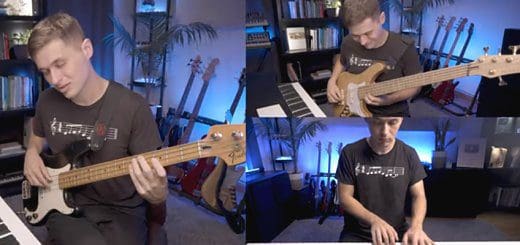Baking soda. You know you need it, but you’re not always sure why. With music, time signatures can be the same. When you are in the studio creating music, everyone can be feeling the vibe, and nobody is talking about a meter.
This is, until you have to set up your session in a DAW, or someone says ‘can you play triplet 16ths for that bar?’. How do you know what 16ths are if you don’t know how long a beat is?
Enter time signatures. These are two little numbers in the top left of your manuscript (next to the key signature) that set the whole grid for your song.
In this article, we will explore what time signature is, look at how it helps us break down the rhythm, discover some examples of how it is used, and learn how to configure it in several DAWs. As we go, what starts out as a fairly rigid theory will hopefully come to life as we move from meter to music; learning how to use the right tools to create a groove and feel.
What Is A Time Signature?
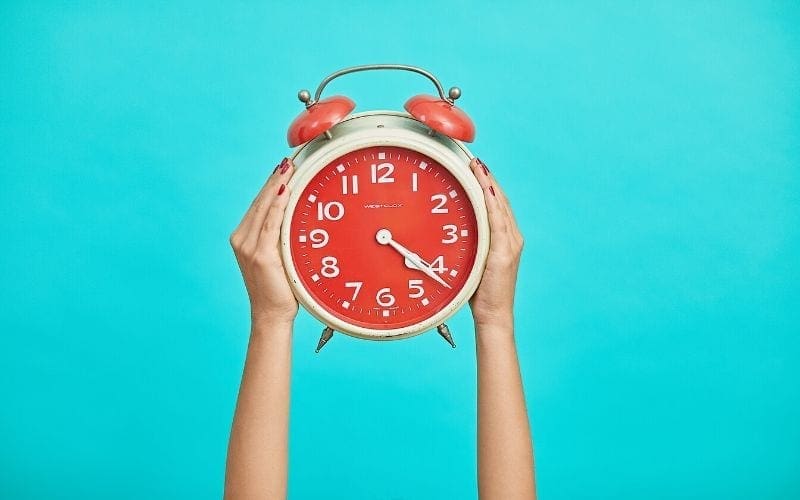
The time signature denotes the meter of composition and the resolution of that meter. Without the jargon – the time signature tells you the number of beats in a bar, and how long each of those beats is.
Bars are a way of subdividing rhythm according to a ‘meter’ (taken from poetic concepts) that guides the composition. In poetry, lines have a set ‘meter’ with a ‘beat’ on emphasised syllables. In music, the ‘lines’ of poetry have become bars, which are divisions of time with a certain number of beats in them.
Time Signature Examples
4/4 Or ‘Common Time’
So, let’s start with everyone’s favourite: 4/4 time. Here it is, with some bar lines:
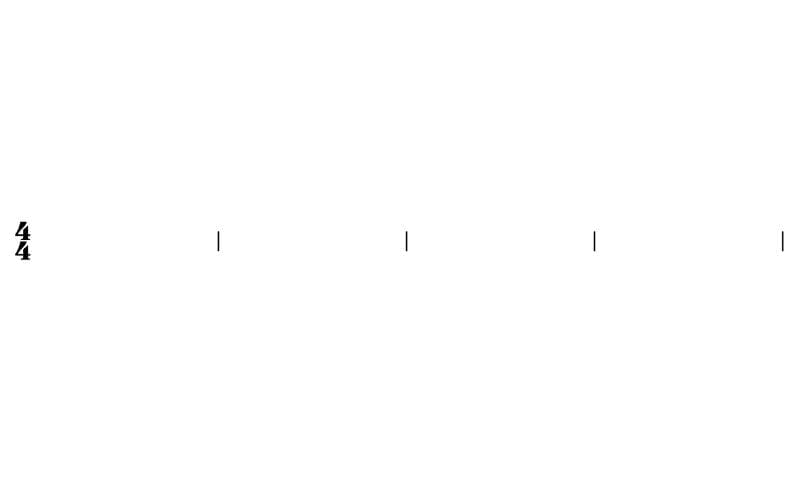
First of all, this is not a fraction. It is just two numbers, each with a different meaning. The top ‘4’ indicates 4 beats per bar. The bottom ‘4’ indicates what type of beat (i.e its length) is counted by how many can fit into a semibreve. If there is a 4 on the bottom, it is counted in quarter notes (or ‘crotchets’), as there are 4 of these in a semibreve).
An 8 on the bottom represents eighth notes (or quavers), as there are 8 in a semibreve. In the bar of 4/4 they look like this:

Fun fact: 4/4 is often represented simply with a ‘C’ in place of the time signature, and is referred to as the ‘common time signature’ (because virtually every song is in 4/4 time).
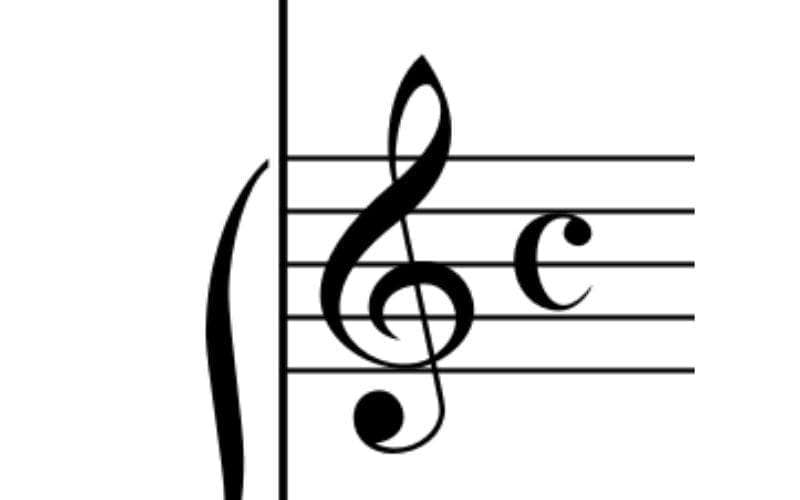
Now, let’s go for two numbers that are different from each other: 2/4. That means two-quarter notes per bar.
6/8
Let’s change both numbers, and look at another common time signature: 6/8. We know that the top number (6) indicates 6 beats in a bar, and the bottom number indicates that these divisions are measured in eighth notes. Here’s 6/8 with six eighth notes:

Review
By way of a brief review, the top number represents the number of beats. The bottom number represents how many of these beats fit into a semibreve. This means that the bottom number will almost only ever be 1,2,4,8,16 or possibly 32 (anything divisible to the power of 2). Exceptions to this rule are known as ‘irrational’ time signatures and are only worth getting into once you have your PhD in music theory.
Is It Duple, Triple Or Quadruple Meter?
Note in the example above that the six eighth notes are grouped into two sets of three. This makes 6/8 a duple meter, with two main emphases in the bar (the first and fourth quavers) – count ‘one two three four five six’. 2/4 time is another example of a duple meter, as is 2/2. 6/4 would also qualify as duple meter because, in 6/4, the emphasis is on beats 1 and 4 (just as it is in 6/8).
Then we have a triple meter. These have three main emphases in each bar. So, 3/4 is the obvious example. Using eighth notes as our subdivision, 9/8 is another triple meter, with emphasis on beats 1, 4 and 7.
Our friend 4/4 is a quadruple meter. You guessed it, these have four main emphases. Therefore, 12/8 is also a quadruple meter, which places the emphasis on beats 1, 4, 7 and 10.
So at the ‘high level’ of duple, triple or quadruple, we’re talking about the main emphases. As we lean on certain beats, hopefully, this all sounds a bit more like music. Sometimes in the studio, you need to understand how those emphases are broken down. Are they in groups of two or three? This is where we need to talk about simple or compound time.
Is It Simple Or Compound Time?

Any time signature that emphasises the beat in sets of two is known as a simple time signature. We have looked at 2/4 and 4/4. 8/4 would equally apply, as long as the emphasis happens on beats 1, 3, 5 and 7. That would be four sets of two.
The way you and I most often hear simple time is with the ‘backbeat’ that drives most rock and pop songs. That is where the drummer plays the kick drum on beats 1 and 3, and the snare drum on beats 2 and 4. 1-2, 3-4. You count them in two sets two.
3/4 also qualifies as a simple time signature, because the three beats comprise two eighth notes each. Remember: any time signature that emphasises the beat in sets of two is a simple time signature. Assuming we emphasise each of the three beats in 3/4, we divide each of those beats down to its next resolution to find out whether it is simple or compound.
So, if simple time emphasises the beat in sets of two, compound time signatures emphasise the beat in sets of three. That makes 6/8, 9/8 and 12/8 (from our above examples) all instances of compound time signatures because they group their beats in groups of three eighth notes.
Understanding the difference between simple and compound meters is probably the most important thing to grasp about time signatures because it’s what defines the difference between (for example) 3/4 and 6/8.
Differences And How To Determine Simple Or Compound Time
Both 3/4 and 6/8 have six eighth notes in the bar. However, in 3/4 we feel three beats in the bar (grouped into twos – one-and-two-and-three-and), and in 6/8 we feel two beats in the bar (grouped into threes – one-and-a-two-and-a).
So, 3/4 is a triple simple time signature and 6/8 is a duple compound time signature.
If all this sounds complex (and it is slightly). I found this table (adapted from the Oxford Companion to Music) very helpful. The top notes of each line denote the main emphases, with the bottom notes showing the complete number of beats in the bar:
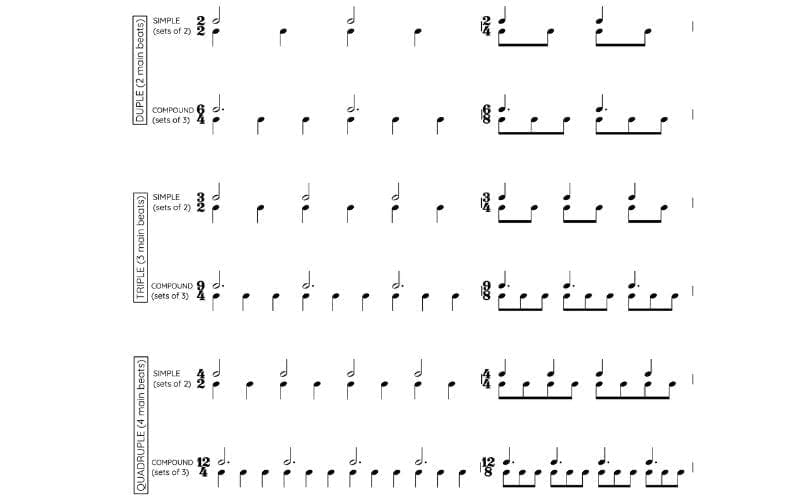
Complex Time Signature – It’s All 2s And 3s
Ironically, complex time signatures are simpler to talk about. So far, all the beats per bar that we have talked about have been neatly divisible (2,4,6,8,12 etc., even 9 was simple 3×3 – a triple compound time signature). Anything that falls outside of these kinds of numbers is what we would classify as complex.
One common example would be 5/4. With this or any other time signature, we simply divide the 5 into a set of 2 and a set of 3. Dave Brubeck’s (and Paul Desmond’s) ‘Take Five’ (being probably the most famous example) emphasises beats 1 and 4, making it 3+2. Here’s the opening piano riff with the 3+2 rhythm illustrated:

Another common complex meter is 7. Pink Floyd’s ‘Money’ provides the classic example of 7, and the most common way it’s broken down (2+2+3). Here’s a piano reduction of the main riff, with the rhythmic emphases:

Sometimes signatures that look simple or compound can in fact be treated as complex. You might use 8/8 to emphasise a 3+3+2 emphasis over what might normally feel like 4/4. You could notate the main riff from Coldplay’s ‘Clocks’ in this way because of its strong 3+3+2 feel:
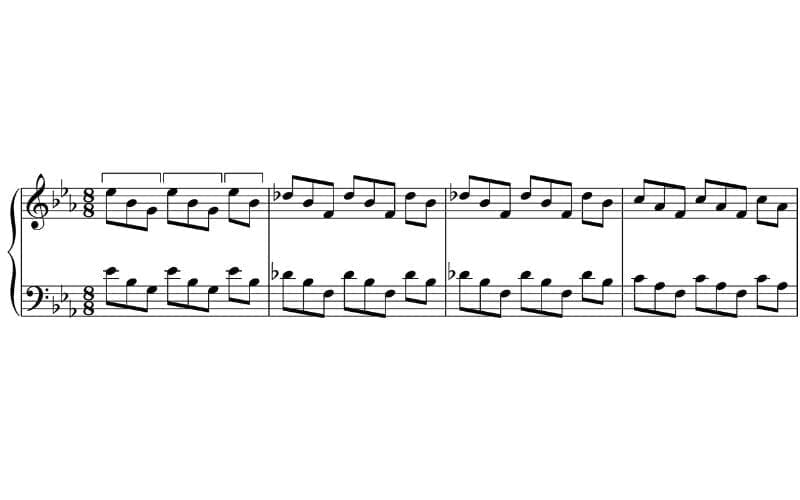
Most of the time though, you would write in 4/4 and people would expect to play syncopated beat patterns ‘across the beat’. But the alternative above is worth knowing about.
There are many other examples of complex time signatures that you may encounter – 11/8, 13/8 – I once heard a tune in 25/8 (you end up just sitting there counting the whole time rather than enjoying the music). Anyway, once you understand that it’s all just groups of 2s and 3s, all you have to do is learn the pattern.
Where To Find Simple, Compound And Complex Time Signatures
Simple
Simple time signatures hardly need talking about. Apart from switching on the radio (which gives you a 99% chance of hearing a song in 4/4 if you’re tuned to a pop station), a couple of other styles are worth a mention.
- Most military/marching tunes are written in 2/4, and go with the steady ‘left, right’ of the marching feet.
- Waltzes are written in 3/4, with a strong downbeat on beat 1 and a lift on beats 2 and 3. Just think of the fairground rides.
- With the vast number of songs in 4/4, there is a huge variety of beat patterns playing across the four beats. These range from simple backbeats to complex polyrhythms, but many still rely on the 4/4 backbone.
Compound
Compound time signatures are worth consideration, especially 6/8, which is the most commonly found compound time signature in pop music. Many blues-style songs have a strong 6/8 feel, just one example being ‘If I Ain’t Got You’ by Alicia Keys. The infamous Star Wars theme is in 12/8, a compound time signature with 4 beats emphasised per bar (a quadruple compound time signature!).
Complex
Complex time signatures can also be heard in a number of well-known pop songs and jazz standards. Sting provides us with the first two, and our friend Dave Brubeck a third.
- You might be forgiven for expecting ‘Seven Days’ to be in 7. Well, it’s in 5. Sting’s writing often fuses various styles, bringing the quirks of jazz harmony and rhythm to pop music. ‘Seven Days’ breaks 5/8 down into the classic 3+2 combo.
- Sting has played with 7 too though, for example on ‘Saint Augustine in Hell’. The rhythm is broken down into the usual 2+2+3 combo. But, note how drummer Vinnie Colaiuta plays across the 7/8 with more of a 7/4 pattern. This means that the emphases on the ride cymbal switch places each bar), creating an interesting polyrhythm:

- Dave Brubeck’s ‘Blue Rondo à la Turk’ is in 9/8 (for the first section of the piece), however, it’s broken down into 2+2+2+3 for the most part (as a complex time signature), with the occasional 3+3+3 compound meter every few bars:
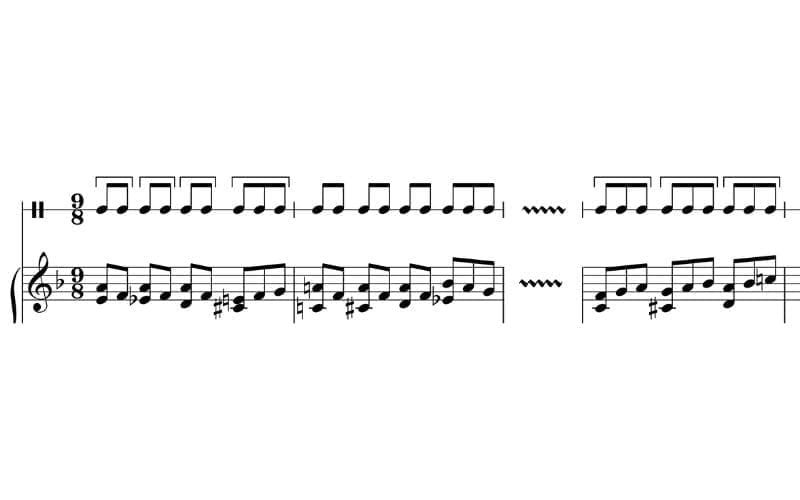
Complex time signatures are at the forefront of musical innovation. The enduring popularity and cultural familiarity with ‘Take Five’ points to the staying power of songs with complex meters. Other artists continue to push and innovate in this area, for example, Tigran Hamsyan. Jacob Collier showed off recently by making a 7/4 time signature sound like a lilting 5/4 groove also.
How To Change The Time Signature In Your DAW

Read on to find out how to change the time signature on your DAW!
Pro Tools
With the transport window open, use the dropdown arrow to select ‘Expanded Transport’. You may need to click it again to select ‘All’ until ‘Meter’ and ‘Tempo’ are visible. Double-click the meter (4/4 by default) to change it. This window also allows you to select the position at which the time signature changes. Having the position set to 1 | 1 | 000 will set the time signature at the start of the session, otherwise type into the first number field the number of the bar at which you want the time signature to change, before making your adjustment.
Cubase
With your play head at the start of the session, double-click on the time signature in the transport to type in your desired time signature (using the / to divide the two parts of the signature). To change the time signature at another point in your session, move the play head to that position then follow the same procedure.
Reaper
In Reaper, double-click the time signature where it appears in the transport at the bottom of the screen and type in the desired time signature using the / key as a divider between the two numbers.
To change the time signature at another position in your session, place the playhead at the beginning of the bar you wish to change, then right-click (Ctrl+click for Mac users) and select ‘Insert tempo/time signature marker’ or hit Shift+C. In the window that opens, select ‘Start new measure, time signature’ and type in the time signature you want.
Logic Pro X
In your Logic session, select the dropdown arrow from the transport display and select ‘Beats & Project’ or ‘Beats & Project (Large)’. You will see your time signature for the project next to/above the key signature. From here, you can select a time signature, or click ‘Custom’ to create an alternative if not shown.
Alternatively, to change the signature, hit ‘G’ to reveal the Global Tracks. If ‘Signature’ is not visible, Ctrl+right-click to reveal a dropdown menu and then select ‘Signature’. The strip will show your time signature for the project as it currently is. Double-clicking on the strip allows you to change it. To add a time signature change part way through, select the bar number by placing the playhead there. Then, click the + button next to ‘Signature’ to create a new time signature at that location.
Conclusion
Taken as pure theory, these concepts may seem dry and academic. Hopefully, with a few examples of how they are used to create a sense of style, some things are beginning to make sense. Time signature sets a musical ‘grid’. It is a rhythmic skeleton for you to put the flesh and bone of the song on. At best, it is something you should be able to ‘set and forget’.
However, this means that you need to understand it as best you can to save friction in the writing or recording process.
If (for example) what you thought was a 3/4 pattern on a guitar actually turns out to be a 6/8 pattern (as revealed when the singer tries to sing their lyrics along and stumbles over the click), it can cause lost time and rethinking of arrangements before you can continue. On the other end of the spectrum, if you get to grips with time signatures, it can yield interesting rhythmic results.
Use a time signature to enable you to feel the natural rhythm of the music, set the measure of music as the poet sets line length, and then let it get out of the way. For more info on music theory, such as intervals – head here.








